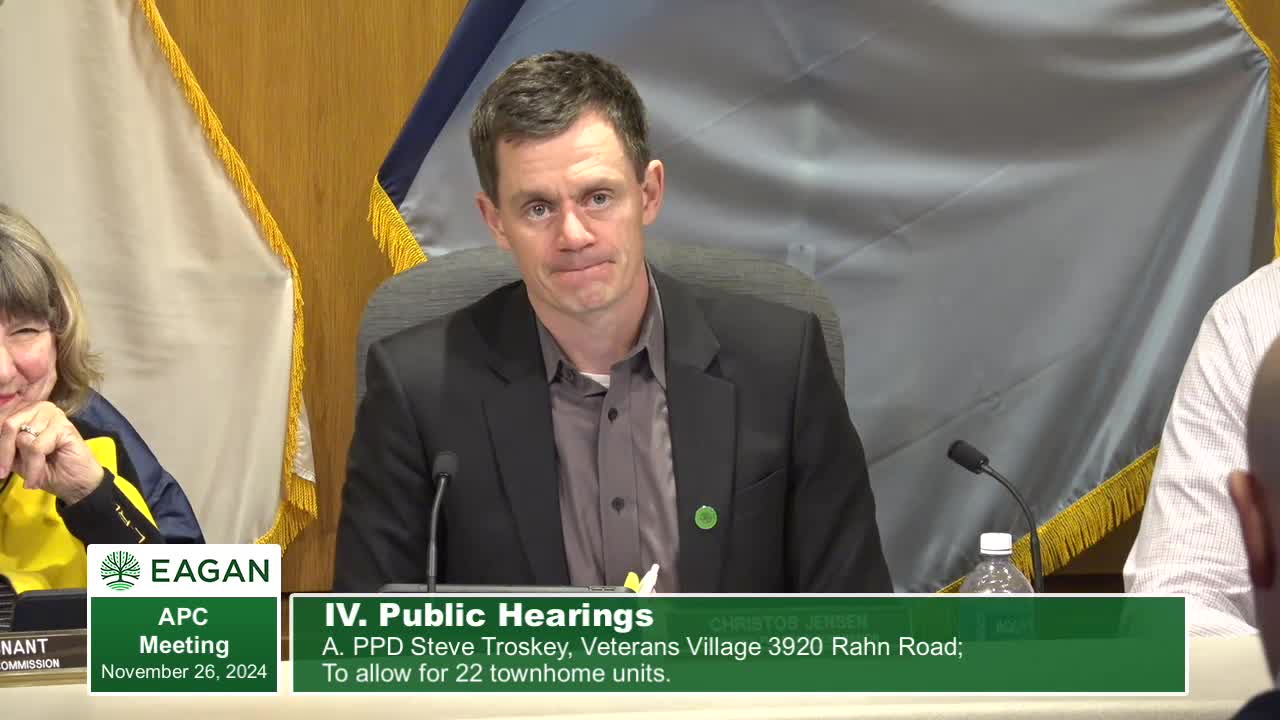Joe Jablonski outlines Veteran Village project to support homeless veterans in Plymouth
November 26, 2024 | Eagan, Dakota County, Minnesota
This article was created by AI summarizing key points discussed. AI makes mistakes, so for full details and context, please refer to the video of the full meeting. Please report any errors so we can fix them. Report an error »

In a recent government meeting held on November 26, 2024, in Eagan, Minnesota, discussions centered around a significant housing project aimed at supporting veterans. Joe Jablonski, representing Veteran Village, introduced the initiative, highlighting the collaboration between public and private entities to address the pressing issue of veteran homelessness.
The project, developed in partnership with Lennar and the Minnesota Assistance Council for Veterans (MACV), aims to provide housing for veterans in need. Jablonski emphasized the rarity of such collaborative opportunities, stating that the alignment of various stakeholders is crucial for creating impactful solutions. He acknowledged that while there are some deviations from standard regulations, the project's unique mission justifies these exceptions.
John LaVold, the Chief Operating Officer of MACV, provided further context by sharing alarming statistics about veteran homelessness in Minnesota. He noted that there are currently 200 veterans on the homeless registry, but the state has achieved a functional end to veteran homelessness in nine out of ten care continuums. LaVold expressed optimism about the project’s potential to make a significant impact, particularly in light of the support from local organizations like Mount Calvary Church.
The meeting also addressed logistical aspects of the housing plan, including site details and parking arrangements. LaVold explained that while only 15% of veterans served by MACV own vehicles, the project will still include covered parking for certain units, acknowledging the varying needs of residents.
Overall, the discussions underscored a community-driven effort to provide essential housing for veterans, reflecting a broader commitment to addressing homelessness and supporting those who have served in the military. As the project moves forward, the collaboration between local organizations and government entities will be crucial in overcoming challenges and ensuring its success. The planning commission's next steps will involve further evaluations and community engagement to finalize the project details.
The project, developed in partnership with Lennar and the Minnesota Assistance Council for Veterans (MACV), aims to provide housing for veterans in need. Jablonski emphasized the rarity of such collaborative opportunities, stating that the alignment of various stakeholders is crucial for creating impactful solutions. He acknowledged that while there are some deviations from standard regulations, the project's unique mission justifies these exceptions.
John LaVold, the Chief Operating Officer of MACV, provided further context by sharing alarming statistics about veteran homelessness in Minnesota. He noted that there are currently 200 veterans on the homeless registry, but the state has achieved a functional end to veteran homelessness in nine out of ten care continuums. LaVold expressed optimism about the project’s potential to make a significant impact, particularly in light of the support from local organizations like Mount Calvary Church.
The meeting also addressed logistical aspects of the housing plan, including site details and parking arrangements. LaVold explained that while only 15% of veterans served by MACV own vehicles, the project will still include covered parking for certain units, acknowledging the varying needs of residents.
Overall, the discussions underscored a community-driven effort to provide essential housing for veterans, reflecting a broader commitment to addressing homelessness and supporting those who have served in the military. As the project moves forward, the collaboration between local organizations and government entities will be crucial in overcoming challenges and ensuring its success. The planning commission's next steps will involve further evaluations and community engagement to finalize the project details.
View full meeting
This article is based on a recent meeting—watch the full video and explore the complete transcript for deeper insights into the discussion.
View full meeting
